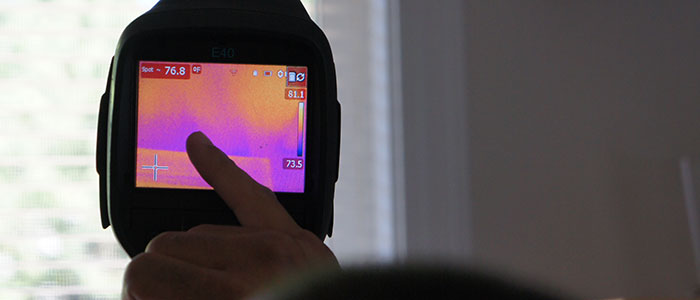
Urban legends of green living
Legend # 1
Turn down the thermostat and you’ll use less energy. Do you keep temperatures low in winter and endure the chill to save energy and money? If your home has significant air leaks, lack of insulation and lack of duct sealing, you will just lose what little heat you are requesting from your heating system, and it will keep running and burning fuel to keep up. While this may save a tiny bit because you are not forcing it to reach higher temps, you’ll spend it on sweaters to wear in the house and hot cups of coffee to warm up.
Green living tip
You’d save more money and be more comfortable if you insulated and air sealed the house, and put in a programmable thermostat so you reduce the heat while you are not home. Sealing air holes around vents and electrical penetrations, duct sealing and insulating properly can save significant energy (some estimates are up to 40%). And programmable thermostats now can be controlled by your phone while you are away. Then you can be cozy when you want to be.
Legend # 2
Riding my bike is the best way to reduce my carbon footprint. Do you limit your use of a car to save greenhouse gases? While cycling to work does limit your vehicle emissions, according to EnergyStar (the conservation arm of the Department of Energy), “the energy used in the average house is responsible for twice as many greenhouse gas emissions as the average car.” The more energy you use at home, the more our highly polluting power plants need to produce, increasing the amount of greenhouse gases. (Source EnergyStar.gov).
Green living tip
While you’ll get in shape cycling and save a little on emissions, the place to reduce your use is at home. EnergyStar recommends the following steps: Use energy saving windows and HVAC systems, maintain those systems (including caulking windows and having tune ups for your heating appliances), and insulating and sealing your house, plus see # 3 for more.
Legend # 3
I have installed EnergyStar certified products in my home so I must be using less energy. EnergyStar sees it another way. While modern appliances from washers and dryers to furnaces use far less energy these days, people have been using far more electricity from all of our plug in devices. This is why total energy use by homes in the US has not decreased. Some estimates are that this “phantom power” use by appliances and electronics can be up to 10% of our total energy.
Green living tip
Unplug. The average home has up to 10 appliances plugged in, in the kitchen alone! Many are drawing some electricity to power clocks, standby lights or indicator lights (to tell you they are off!). One of us has this in our kitchen: toaster oven, microwave, food saver, coffee maker, mixer, electric can opener, range, dishwasher, garbage disposal, overhead lighting, ipod docking station, and refrigerator = 12!. Add all the phone chargers that stay plugged in when not in use, computers, TVs, game consoles, cable box, hair dryer, electric toothbrush, water heater, and it adds up to a significant amount of excess power use. Do an experiment and try: turning lights off when you leave the room, and plug non-core appliances and computers into a power strip that you turn off when you are out, and you should see a difference.
Legend # 4
We don’t waste water because we never let water run (eg: in the sink while washing dishes or before a shower). For most homes, the biggest culprit wasting water in your house is the toilet(s). If it was made before 1994, it’s not a low flow toilet. One of us here at Washington Energy has a 1926 toilet using 7 gallons of water each flush. That’s about 42 gallons a person per day. Most toilets from the post-war period to the 80s used between 3.5-5 gallons per flush.
Green living tip
There are inserts that can fit some units and hold back a gallon of water each flush, but if you want to save significant amounts of water, you’ll need a modern toilet with 1.6 gallons per flush. These will pay for themselves quickly as your water use will decrease. Some of the WaterSense certified toilets we install have significant local utility rebates, up to $80.
Legend # 5
‘All natural’ equals ‘good to buy’. Are you looking for certain words on packaging when you make a purchase decision? The words natural, green, eco-friendly, or biodegradable are not regulated or based on any standards. (Organic is regulated, and certified organic is inspected.) Biodegradable means it will degrade “someday” which covers almost everything, technically even nuclear waste.
Green living tip
Buy something because it’s the best product for you, and be cautious if basing a purchase decision on these un-regulated words. And right now, genetically modified foods used as ingredients such as corn starch or soy protein are not required to be labeled either, so do not assume that “natural” means it’s not in there. There is no strict definition of what makes a natural food.
Related Products
Suggested Reading
- 2016
- AC
- AC Installation
- AC Units
- AFUE
- air conditioing
- air conditioner
- air conditioning
- air conditioning maintenance
- air conditioning service
- air conditioning tune-up
- air duct
- air duct cleaning
- air handlers
- air pollution
- Air Purification System
- air purifier
- Air Sealing
- angie's list
- award
- basement Finishing
- Bathroom remodel
- BBB
- BBB Accredited Business
- before and after
- Best air conditioner
- best filters
- best generator
- best locks
- best water heater
- best window install
- boilers
- bryant
- Bryant AC
- bryant furnace
- bryant heat pump
- christmas lights
- clean air
- clothes drive
- Clothes For Kids
- coat drive
- combi-boiler
- comfort
- community
- Construction
- contractor
- contractors
- Cooling
- Cooling equipment
- Coronavirus Protection
- custom
- daikin
- deals
- discounts
- DIY
- Donation
- Donations
- door hardware
- door installation
- door replacement
- Door Transformations
- doors
- drafty home
- drain cleaning
- Duct Cleaning
- Duct Cleaning Services
- ductless
- Ductless heat pump
- ductless heat pump. mini-split
- Ductless heat pumps
- ductless heating system
- ductless heating systems
- ductless installation
- Ducts
- durable
- earth day
- eco friendly
- EER
- election
- electrical inspection
- emergency
- energy
- energy conservation
- energy efficiency
- energy efficiency rebates
- energy efficient AC
- energy efficient air conditioner
- energy efficient home
- energy efficient hvac
- energy efficient HVAC Systems
- energy efficient windows
- energy myths
- energy saving
- energy saving home products
- energy star
- energy tax credit
- environmentally friendly
- exterior doors
- exterior siding
- fall
- fall weather
- fiber cement
- fiber cement siding
- fiberglass doors
- filter
- filter change
- financing options
- fireplace
- fireplace insert
- fireplace repair
- fireplace tune-up
- front door
- furnace
- furnace filters
- furnace install
- furnace maintenance
- furnace mileage
- furnace problems
- furnace replacement
- furnace service
- furnaces
- Garage door replacement
- gas fireplace
- gas fireplace inserts
- Gas Fireplace Makeover
- gas furnace
- generators
- going green
- good business practices
- green solutions
- Guardian Maintenance Club
- gutters
- heat
- heat pump
- heat pump installation
- heat pump maintenance
- heat pump vs ac
- Heat Pumps
- heat pumps maintenance
- heat wave
- Heating
- Heating and Cooling equipment
- heating and cooling systems
- Heating Brands
- Heating Control
- Heating equipment
- Heating System Tuneup
- heatwave
- HEPA filter
- history
- holiday
- home
- home buyer
- home energy
- home energy efficiency
- Home energy efficiency solutions
- home exterior
- home heating
- home improvement
- Home Improvement Rebates
- home improvement repair
- home inspection
- home maintenance
- home maintenance checklist
- home maintence
- home performance
- home protection
- home repair
- home safety
- home upgrade trends
- home upgrades
- home value
- homeowners
- honeywell
- hot water
- hot water heater
- houzz
- how to
- HVAC
- HVAC Contractor
- HVAC Contractors
- hvac system
- IAQ
- indoor air quality
- infographic
- install
- install furnace
- insulated composite siding
- insulation
- intellihot
- interior doors
- james hardie
- kids
- Kitchen face lift
- LED light
- LED lights
- light bulb
- light bulbs
- locks
- mailbag
- maintenance
- march
- membership
- mini-split
- modulating furnace
- money saving
- money savings
- navien
- new door installation
- new home
- New homeowner
- new siding installation
- new windows
- news
- pacific northwest weather
- patio doors
- pets
- plank siding
- plumbing
- plumbing inspection
- pnw
- power
- power outages
- precision tune up
- preventative
- Pro Tips
- Programmable Thermostat
- Programmable Thermostats
- propane
- PSE Award
- PSE Energy
- PUD
- Q & A
- rain
- Ratings
- rebates
- refund
- REME Halo
- Remodel
- remodeling hacks
- Replacing Heating System
- reputation
- Safe Home Insulation
- sale
- save energy
- Saving money
- scam
- scams
- seamless
- seamless gutters
- seattle
- Seattle Weather
- SEER
- service
- services
- shingle siding
- Siding
- Siding replacement
- sliding glass doors
- Smart Home
- Smart thermostat
- smoke
- snow
- Solar Attic Fan
- solar power
- Solar Powered Light Strand
- sound
- spring
- standby generators
- storm doors
- summer
- summer fires
- Summer heat
- Summer home
- super service 2016
- tank water heater
- Tank water heaters
- tankless tune ups
- tankless water heater
- tankless water heaters
- tax rebate
- thanksgiving
- Thermostat
- tips
- trends
- tune-up
- upgrade
- upgrade cooling
- upgrade heating
- utilities
- utility rebates
- veterans
- Washington Energy
- washington energy services
- water conservation
- Water Heater
- water heater installation
- water heater maintenance
- water heater repair
- water heaters
- water leak protection
- Wildfire Season
- wildfire smoke
- window
- window energy efficiency
- window install
- window maintence
- window remodel
- window repair
- window replacement
- windows
- winner
- winter
- zone heating
- Air Conditioning
- Air Purifiers
- Cooling
- Doors
- Ductless heat pump
- Environmental
- Fireplace
- Furnace
- Gas fireplace
- Generators
- Heat pump
- Heating
- Home improvement
- How to
- HVAC
- Indoor Air Quality
- Insulation
- News
- Plumbing
- Rebates
- Seattle
- Siding
- Smart Home
- Tank water heaters
- Tankless water heaters
- Tips to save money
- Uncategorized
- Wildfire Season
- Windows


